Atlantic Ocean billfishes
Sailfish and swordfish are large marine predators known as “billfishes” because of their long snouts. These fishes can be found from 10 m to 800 m deep - depending on the species1 Their large eyes suggest that they are highly visual predators, adapted to maximize visual performance in both shallow water and deep oceans.
Many fishes that live in shallow water are generally affected by the decrease in water temperature, which reduces body temperature, metabolism, and performance. However, fish such as swordfish, sailfish, some tunas, and several species of sharks are able to maintain their body temperatures above the water temperature when hunting in these areas.
This is made possible by a highly specialized heating system that heats their eyes and brains 10 to 15° C (50 to 60° F) above the ambient temperature. By heating their retinas, billfish can more easily detect and track prey at high speeds.
Depending on the depth of the dive, the heating can make the temporal resolution up to ten times faster than fishes that are unable to heat their organs. The heated eyes and brain give these highly visual ocean predators a decisive advantage over agile prey.2 3
Swordfish (Xiphias gladius)
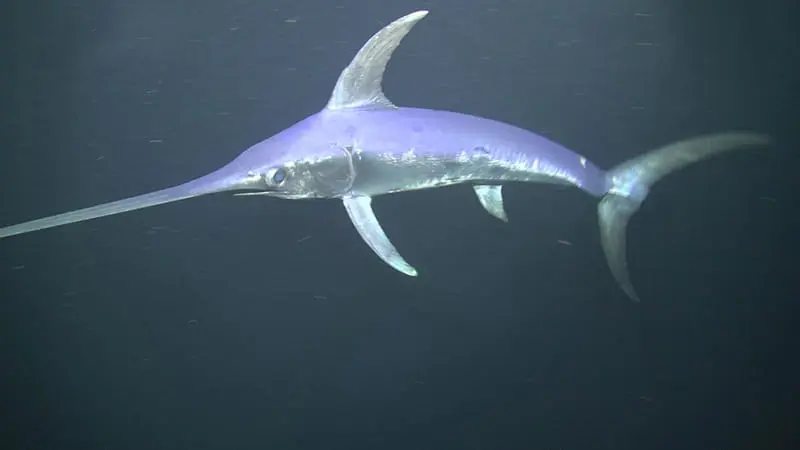
The swordfish’s snout is the largest of all billfishes, measuring up to a third of its body. It has been suggested that the swordfish’s long snout is an adaptation that improves the hydrodynamics of its swimming. However, some researchers believe they use it to injure or kill their prey, as pieces of their beaks have been found wedged in sharks , whales, and other large fishes.
This fish usually reaches 3 m (10 ft) and over 100 kg (220 lb), but there are records of individuals weighing over 500 kg (1,100 lb) and up to 4.5 m (15 ft).
Swordfish have been fished on a large scale in Brazil since the 1950s, using a large line 80 to 200 km long,4 with 800 to 1,200 secondary lines with baited hooks attached. This method is known as “longline fishing” and is also used to catch tuna, dogfish and mahi-mahi5.
The effects of fishing on swordfish populations have been monitored and analyzed since the 1980s. Although fishing has not been fully controlled, swordfish are abundant and are listed as “least concern” on the International Union for Conservation of Nature and Natural Resources (IUCN) Red List of Threatened Species.1
Marlins (Istiophoridae)
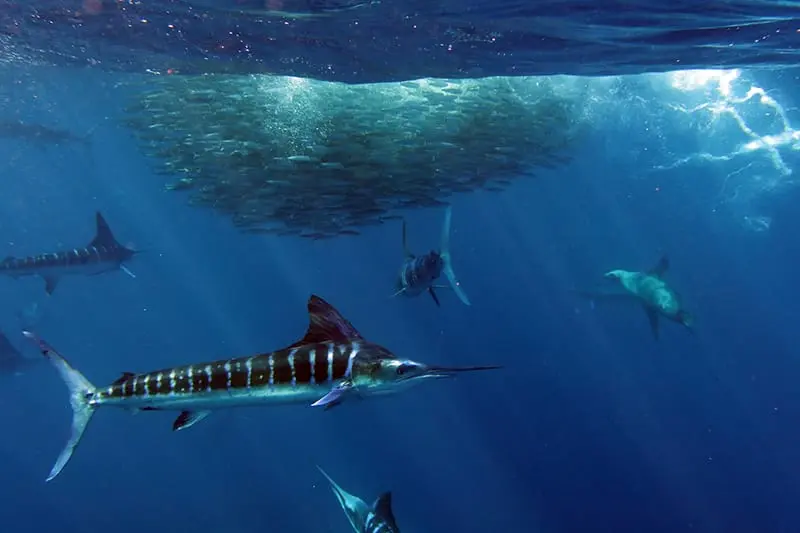
There are other fish that are also mistakenly called swordfish and are often confused with swordfish. They are those of the family Istiophoridae — known as marlins or sailfish. Although swordfish and marlin look similar at first glance, they have several characteristics that make them easily distinguishable.
Like swordfish, marlins have a long snout, but theirs is needle-shaped, while the swordfish’s is flat. The main characteristic of sailfish is their long, flexible dorsal fin, which opens like a fan or crest - the swordfish’s dorsal fin is rigid and pointed like a shark’s.
While swordfish are usually grayish, marlins are eye-catching with their strong, contrasting colors. Such is their beauty that they have become synonymous with great success in sport fishing.
Taxonomy
There is controversy about the number of genera and species of marlins, consequently, the delineation of the range of each species is also confusing.6
Nevertheless, between three and five genera are considered valid, these being: Istiophorus, Makaira, Kajikia, Istiompax and, Tetrapturus. These genera contain between nine and twelve species, among which six are considered inhabitants of the Atlantic Ocean and the Brazilian coast.7
Istiophorus
Although some scholars claim that there are two species in the genus — Indo-Pacific sailfish (I. platypterus) and Atlantic sailfish (I. albicans) — a 2006 study stated that there is no solid evidence that they are distinct species. The Pacific sailfish, however, is larger (about 100 kg (220 lbs)) than the Atlantic sailfish (about 68 kg (149lbs)).8
Indo-Pacific sailfish (I. platypterus)
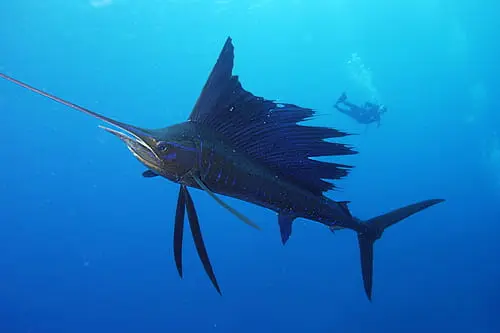
The Indo-Pacific sailfish is one of the most iconic species, easily recognized by its extremely large and colorful fins. In the Indo-Pacific Ocean (where it lives), the species can grow to over 3 meters in length.
It is also the most commonly caught species in the tuna longline fishery in the northeastern region of Brazil. However, because it is relatively common in both oceans and there is no evidence of widespread decline, the sailfish is listed as “Least Concern” on the IUCN Red List of Threatened Species.6
Makaira
The genus Makaira, is usually divided into two species: the Atlantic blue marlin (M. nigricans) and the Indo-Pacific blue marlin (M. mazara). But, like the genus Istiophorus, analyses indicate no divergence between Atlantic and Indo-Pacific individuals — with, so far, only one species breeding separately in each ocean.6
Blue marlin (M. nigricans)
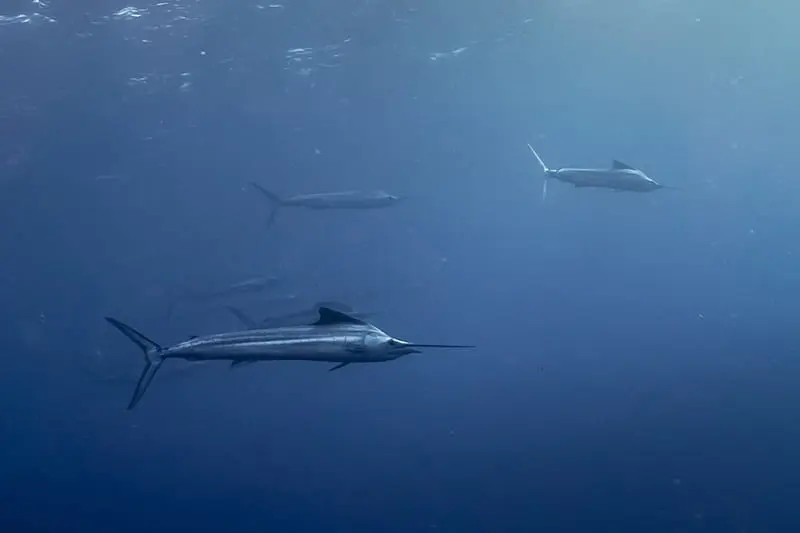
The species inhabits tropical and temperate waters of the Atlantic and Indo-Pacific Oceans. It is one of the most popular species for sport fishing around the world. Likewise, it is targeted for overfishing due to its frequent capture as accompanying fauna for tuna during longline fisheries in the Atlantic Ocean.7
It is a large species, with a maximum length of 3.75 m (10 feet) and reaching a weight of 580 kg (1,000 lb). The blue marlin is one of the few species in the sailfish family that is vulnerable to extinction.6
Kajikia
The genus Kajikia is also currently divided into two species: the white marlin or white sailfish (K. albida) and the striped marlin (K. audax). Although they are apparently different species, genetic analyses have not been conclusive, so there is no consensus on the existence of two species. It is estimated that the genus split very recently — therefore, the more traditional methods of molecular identification are less efficient, so more studies need to be done for a concrete analysis.
White marlin (K. albida)
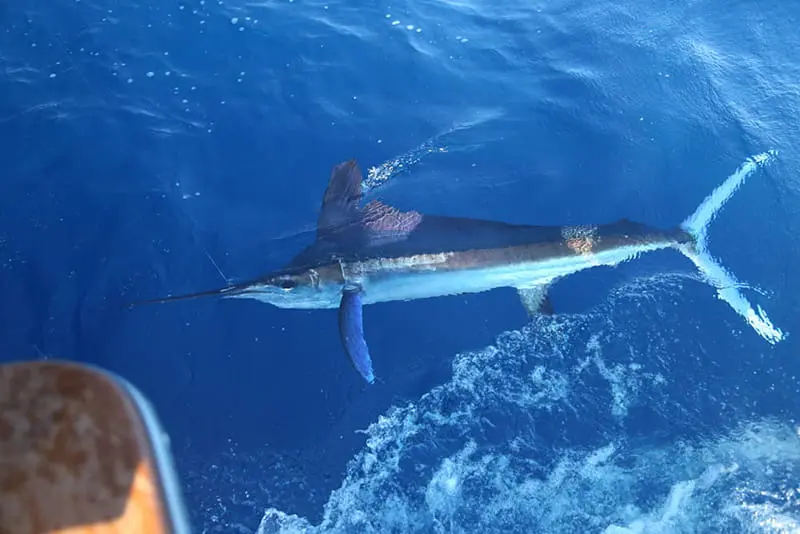
It was initially classified as Tetrapturus albidus, but currently the scientifically accepted name for the species is Kajikia albida — according to the World Register of Marine Species.9
The species reaches a maximum length of 2.80 m (6 ft) and can weigh up to 82 kg (180 lb), but most of those caught are around 1.65 cm (4.65 in) and weigh an average of 20 to 30 kg (44 to 66 lb).
Although it is not intentionally fished in Brazil, the country is the second largest catcher of white marlin after tuna and swordfish due to its abundance on the western side of the South Atlantic. It is densely distributed from May to October in northeastern Brazil and from November to April in southern Brazil and Argentina.
Together with the black sailfish (M. nigricans) and the Atlantic sailfish (I. platypterus), it constitutes the main sailfish species caught in the Atlantic Ocean. It is also vulnerable to extinction.6 10
Tetrapturus
Although there is disagreement in the classifications of sailfish across genera, the genus Tetrapturus is the most uncertain. Currently, there are four accepted species: roundscale spearfish (T. georgii), Longbill spearfish (T. pfluegeri), Mediterranean sailfish (T. belone), and the shortbill spearfish (T. angustirostris).
Although the roundscale sailfish is genetically the most distinct of the four, it has recently been confirmed as a valid species. Similarly, the longbill spearfish and Mediterranean sailfish were until recently considered to be the same species6.
Of these four species, two are found in Brazilian waters: the longbill spearfish and the roundscale spearfish.
Longbill spearfish (T. pfluegeri)
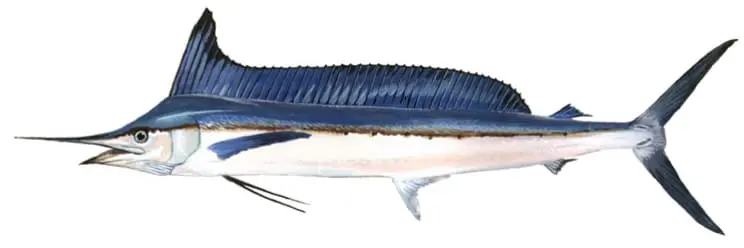
The longbill spearfish is one of the smallest sailfishes, reaching a maximum length of 2 m (6 ft) and 45 kg (100 lb). However, the average length caught on longlines in the Atlantic fishing grounds is 1.65 m (5 ft)11.
Like other sailfishes, although it is not targeted in commercial fisheries, it is caught as bycatch fauna because it inhabits and has a similar diet to high-value commercial fish. It is also widely caught in sport fisheries as are white and blue marlins, and the Indo-Pacific sailfish.12 Despite this, the species does not raise concerns about its population, being classified as “Low Concern” on the Red List of Threatened Animals..6
Roundscale spearfish (T. georgii)

The presence of this species, initially limited to Sicily, the Strait of Gibraltar, and the waters around Madeira Island, has recently been extended to the Atlantic from its recording by scientific observations.
It is one of the smallest species of spearfis, with the largest specimen (measuring 2 m) being caught by a Venezuelan fishing boat.13
The Roundscale spearfish (T. georgii) and Longbill spearfish (T. pfluegeri), are commonly confused with the white sailfish (K. albida) by fishermen because they are so similar. Since the commercialization of white sailfish is prohibited, it is necessary to correctly identify them - mainly by comparing the shape of their fins14.
In addition to complying with the law, such identification helps to estimate the population status of the species, which is currently listed as “Data Deficient”6.
Fishing and Conservation
Although longline fishing is more selective than trawling, for example, it is inevitable that some accompanying species are caught.11 However, throughout Brazil, the Normative Instruction of the Special Secretariat for Aquaculture and Fisheries (INSEAP No. 12/2005) prohibits the sale of white and blue marlins, Indo-Pacific sailfish, and Longbill spearfish, and it is also prohibited to throw back into the sea any animals that are already dead when the hooks are removed.
Thus, blue marlin and white marlin that are alive when the hooks are set must be returned to the sea. However, longline fishing often catches fish that do not resist for long, and are found dead when the longline is retrieved.
In such cases, all dead white or blue marlins should be brought ashore and donated to scientific or other charitable institutions.15 This national measure may have influenced the large decline in blue sailfish catches in the country since 2004.
Historically, Brazil is the largest responsible for the incidental catch of marlins in the Atlantic Ocean, thus being a major contributor to the mortality of these species due to fishing. 7
Even though they are frequently caught by bycatch worldwide, marlins are mostly listed as “Least Concern” or at most as “Vulnerable” — the lowest levels of threat of extinction according to the IUCN Red List.
This is because they are widely distributed throughout the oceans, are relatively common, and there is no evidence of widespread decline - even if many aspects of the species' biology are not yet fully understood.6,7
Read more:
-
ICMBio - Estudos biológico-pesqueiros do espadarte (Xiphias gladius, Linnaeus, 1758) capturado pela frota de espinhel-de-superfície sediada em Itajaí (SC), no Atlântico Sdoeste. ↩︎
-
Current Biology - Warm Eyes Provide Superior Vision in Swordfishes ↩︎
-
National Institutes of Health (NIH) - Structure of the brain and eye heater tissue in marlins, sailfish, and spearfishes ↩︎
-
Repositório Ifes - Caracterização da Pesca de Espinhel no Município de Piúma - Espirito Santo ↩︎
-
Repositório Institucional UNESP - Delimitação de espécies da família Istiophidae e de estoques genéticos do agulhão-vela Istiophorus platypterus no Oceano Atlântico ↩︎
-
ATTENA - Repositório Digital da UFPE - Utilização de habitat e movimentos migratórios do Agulhão Negro (Makaira nigricans) no oceano Atlântico Sul ↩︎
-
Ingenta Connect - Phylogeny of recent billfishes (Xiphioidei) ↩︎
-
ATTENA - Repositório Digital da UFPE - Distribuição e Abundância Relativa do Agulhão Branco (Tetrapturus albidus Poey, 1860) Capturado No Oceano Atlântico. ↩︎
-
Biblioteca Digital de Teses e Dissertações - Modelos lineares generalizados no estudo de proporções de agulhões vela (Istiophorus albicans) e verde (Tetrapturus pfluegeri) na pesca de atuns com espinhel no oceano Atlântico ↩︎
-
ResearchGate - Hábito alimentar do Agulhão-Verde, Tetrapturus pfluegeri (Robins & de Sylva, 1963), (Teleostei-Istiophoridae), capturado no Atlântico Oeste Tropical ↩︎
-
UniSanta - Dados Preliminares Acerca do Hábito Alimentar do Agulhão Redondo, Tetrapturus georgii (lowe 1840) Capturado no Atlântico Oeste Tropical ↩︎
-
Instituto de Pesca - Análise da pesca da frota atuneira do estado de São Paulo: ênfase aos agulhões ↩︎
-
ICMBio - Instrução normativa SEAP/PR n° 12, de 14 de julho de 2005 ↩︎
